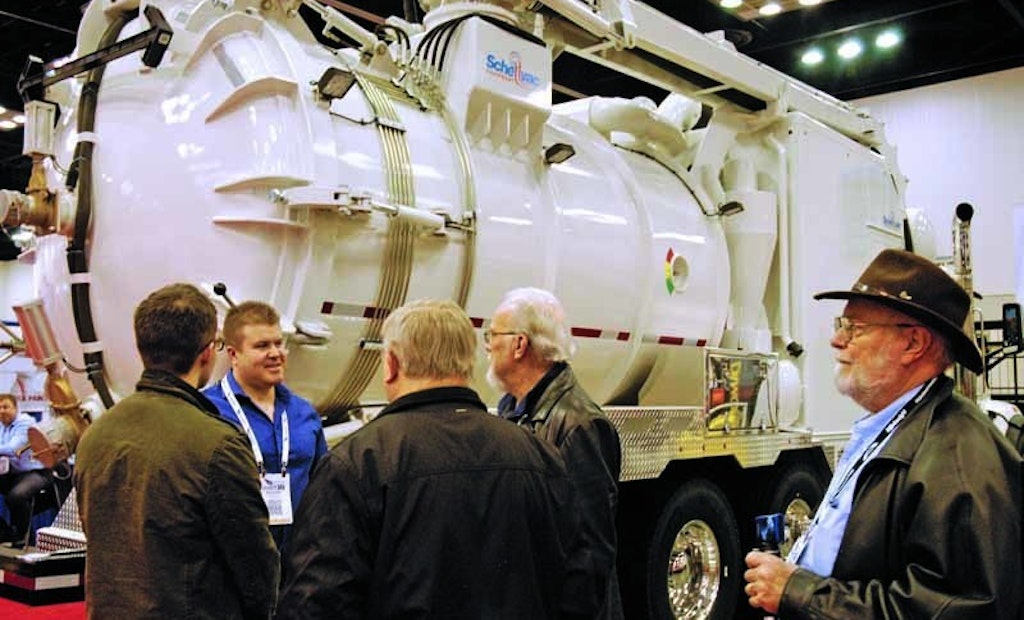
Interested in Cleaning?
Get Cleaning articles, news and videos right in your inbox! Sign up now.
Cleaning + Get AlertsIn the booming hydroexcavation industry, packing high power into a compact package is preferred. The people at SchellVac Equipment took that to heart when designing the SCH VT 2600 Tri-Drive Hydroexcavator, which was introduced at the 2016 Water & Wastewater Equipment, Treatment & Transport Show. And many attendees of the show took notice.
“This is about as big of a system and as much power as you can get on a single-chassis truck,” says SchellVac President Alexander Scheller. “It’s a big, powerful unit, but because it’s on the single chassis, it’s actually proportionally small for the power it provides.”
The system is built on a 2016 Peterbilt 567 tri-drive triple-axle system that is rated to a 66,000-pound payload, with power from a Cummins ISX15 engine delivered through an efficient 18-speed transmission.
“Companies are looking to hydroexcavation trucks as a main source of income, so they need a unit that is easy to operate and allows them to get the job done well and fast,” he says.
“The bigger trucks are becoming a better fit for the crowd at this show, and this one is our big boy.”
The SCH VT 2600 boasts a large, hoisted 15.5-cubic-yard debris body with full-opening rear doors and hydraulic locks. A high-power Robuschi RBDV 145 blower provides 6,400 cfm and vacuum force at 28 inches Hg, powered by a NAMCO direct-drive transfer case. Debris is filtered through a heavy-duty cyclone and cartridge system. Its 8-inch telescopic boom provides 27 feet of reach and 320-degree rotation, with 20-degree down tilt and 55-degree uptilt, allowing the operator to reach more of the job without needing to reposition the unit.
“A lot of the contractors we are talking with are impressed by the big blower with higher cfm output than they are used to,” Scheller says. “We also took great care to make sure that the vacuum system is easy to maintain.”
The high-pressure washing and blasting system has a 1,200-gallon aluminum water tank to allow the operator to stay on site for longer work periods instead of breaking for water fills.
Blasting power is provided by a CAT Pumps 3560 pressure pump that offers 3,400 psi at 20 gpm. A 980,000 Btu boiler heats water for additional blasting effectiveness. The unit conveniently features a hose reel on each side of the unit, while a glycol system enables damage-free use in cold winter months. In addition, the complete water system is installed in a fully insulated and heated aluminum van body for cold climates.
“We know that not everyone is going to need the heated system, and that we’re basically building these units for the northern portion of the United States, and all of Canada,” says Scheller. “It is important that companies in those colder northern climates have a unit that can run year-around.”
While SchellVac has been in the vacuum truck industry for 10 years, the larger hydroexcavation units are a relatively new endeavor for the company. Scheller says the big goal he had for his company coming into the WWETT Show was to introduce the new units to attendees, while reminding long-time customers that their smaller vacuum and septic pump trucks are still a focus of the company.
“We wanted to let people know that we are expanding and branching out, and our hydroexcavators are made with the same quality that we’ve put into all our vacuum trucks over the years,” he says. “We’re looking forward to coming back next year with even more options for those at this show.” 877/336-0081; www.schellvacequipment.com.





